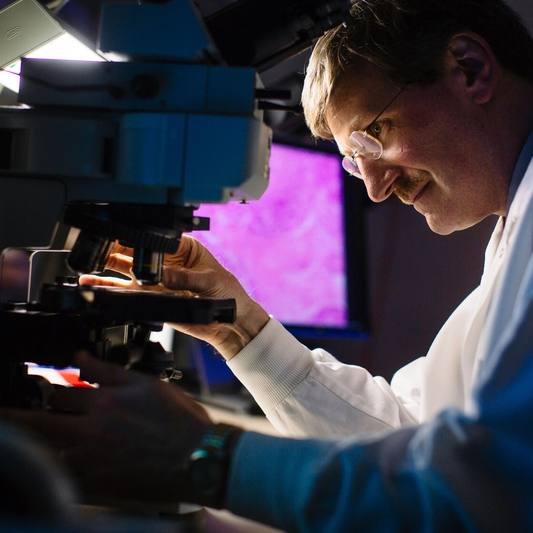-
Research
Second Language Learning Linked to Brain Surgery Recovery

By Lynda De Widt
Researchers at Mayo Clinic in Florida report differences in clinical outcomes between “late bilingual” and monolingual glioblastoma patients undergoing awake brain surgery for tumor removal — information that could help guide surgeons in the operating room. Their findings, published in the Journal of Neuro-Oncology, suggest that bilingual patients who have learned a second language after around age 6, called late bilinguals, had fewer complications and an improved surgical recovery than patients who spoke one language.
“Our study results highlight that there are differences between the monolingual and bilingual patient populations, which inform our surgical decision making,” says Mayo neurosurgeon Alfredo Quinones-Hinojosa, M.D., senior author of the study and the William J. and Charles H. Mayo Professor. “Based on this information, we can involve the patient to give them a choice on which language they prefer to preserve and use for daily life.”
For the study, researchers analyzed data from 56 patients who had undergone a left-sided awake craniotomy between September 2016 and June 2019. This is a type of surgery that allows surgeons to ask patients questions during surgery to help preserve movement and speech. Of these patients, 14 were bilingual, with second languages of English, Spanish, French, Arabic, German, Estonian and Lithuanian, and 42 were monolingual controls. All participants had tumors that invaded areas of the brain responsible for language. Patient demographics, education level and the age of language acquisition were documented and assessed. All patients had received the equivalent of a college education or higher, and self-reported their second language proficiency, which was evaluated by certified translators.

The patients acquired their second language after the age of six and were considered “late” bilinguals. “Early” bilinguals, according to research cited in the paper, are people who learn a first and second language simultaneously before the age of six, and who are more similar to monolingual people in terms of language center location in the brain.
“In a simple analogy, if you consider these language centers as cities, and the roads connecting them as neurons, the early bilinguals are like one big city,” says Karim ReFaey, research fellow and first author of the study. “The late bilinguals would be considered two neighboring cities with many connecting roads in-between. Recognizing the differences in these spatial areas of the brain controlling language can help guide surgical approach.”
When neurosurgeons perform awake brain surgery, they can “test” these areas of the brain to know which ones to avoid and preserve. This is done through during brain mapping. The process involves the use of direct electrical cortical stimulation. The neurosurgeon energizes surrounding structures of the brain with electrical currents, and by observing the patient’s response, can tailor the surgery plan and determine areas not conducive to tumor removal.
The study showed that none of the bilingual patients experienced seizures during brain surgery, a potential complication of the procedure, while 7% of the monolingual patients did. The bilingual patients tolerated more electrical stimulation and higher levels of electric current; however, these patients also had less of their tumor removed (as measured by volume) than monolingual patients due to their tumors having less defined boundaries. The study noted that the bilingual patients scored higher post-surgery on the Karnofsky Performance Status Scale, a standard index for measuring a cancer patient’s ability to perform ordinary tasks (84.3 score for the bilingual patients, versus 77.4 for the monolingual patients). A higher score indicates a patient is better able to carry out daily activities.
The Mayo team plans to extend these findings with a prospective study involving more patients, with the ultimate goal of creating a guide for surgical approach and intervention in the bilingual patient population.
Other researchers on the study include Shaswat Tripathi, Adip Bhargav, Sanjeet Grewal, M.D., Eric Middlebrooks, M.D., David Sabsevitz, Ph.D., Mark Jentoft, M.D., William Tatum, D.O., Anthony Ritaccio, M.D., and Kaisorn Chaichana, M.D., all of Mayo Clinic; and Peter Brunner, Ph.D., Albany Medical College, and Adela Wu, M.D., Stanford University School of Medicine.
This research was supported by the Mayo Clinic Professorship and a Clinician Investigator award, the Florida State Department of Health Research Grant, the Mayo Clinic Graduate School of Biomedical Sciences, and a National Institutes of Health grant.
Conflict of interest statement: Drs. Tatum, Quinones-Hinojosa, and ReFaey filed a patent disclosing a circular grid device and technology. The other authors listed on the paper report no conflict of interest.
###







